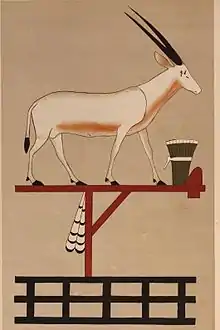
The Oryx nome (Ancient Egyptian: 𓉇 Ma-hedj) was one of the 42 nomoi (administrative divisions, Egyptian: sepat) in ancient Egypt. The Oryx nome was the 16th nome of Upper Egypt,[1] and was named after the scimitar oryx (a type of antelope). It was located, approximately, in the territories surrounding the modern city of Minya in Middle Egypt.
History
The nome is mentioned on vessels found in the pyramid complex of king Djoser, who ruled at the beginning of the Old Kingdom. Near Zawyet el-Maiyitin were buried the local governors of the late Old Kingdom.[2]
Most of the history of this nome in the Middle Kingdom comes from the rock-cut tombs of its nomarchs, which were buried at Beni Hasan.[1] Like many other nomes, the Oryx nome rose to prominence during the First Intermediate Period, an epoch that witnessed the decline of royal power and the increase of the local governors' influence. When, during the end of this period, the 11th Dynasty of Theban rulers were close to defeating the rival 10th Dynasty of Herakleopolis, the nomarch of the Oryx nome Baqet III switched from neutrality to an allegiance to the Thebans.[3] Subsequent nomarchs managed to gather a considerable amount of wealth between the late 11th to middle 12th Dynasty, as shown by their large and finely decorated tombs at Beni Hasan; some of these governors, like Khnumhotep II, also held the national-level office of Overseer of the Eastern Desert.[1]
During the highly centralized reign of pharaoh Senusret III, the power of the nomarchs of the Oryx nome may have declined dramatically, as no burials of governors were found after his reign.[4] In the Second Intermediate Period this nome became part of the 15th Upper Egyptian nome and disappeared as its own administrative unit.[5]
Cities and deities
The Oryx nome governed many important cities but for most of these the exact locations are still uncertain: Akoris (modern Tihna el-Gebel), Men'at Khufu (possibly Minya), Hebenu (possibly Kom el-Ahmar), Nefrusy (location unknown) and Herwer (possibly Hur).[1][6]
The capital of the Oryx nome is far to being securely determined. It may have been Herwer, though the nomarchs' necropolis is at Beni Hasan which was likely close to Men'at Khufu, and is known that some governors such as Khnumhotep I were both nomarch and governor of Men'at Khufu.[1]
According to the inscriptions on the White Chapel of Senusret I, the local god of the Oryx nome was Horus of Hebenu. Other important deities were Hathor at Nefrusy and the couple Khnum-Heqet at Herwer.[1][7]
Nomarchs of the Oryx nome
The following is a genealogy of the nomarchs of the Oryx nome during the late 11th and 12th Dynasty (the limit between the two dynasties passes approximately along the third and fourth generations). The nomarchs are underlined.[8]
| Ramushenti | |||||||||||||||||||||||||||||||||||||||||||||||||||||||||||||
| Baqet III | |||||||||||||||||||||||||||||||||||||||||||||||||||||||||||||
| Khety | Baqet♀ | ||||||||||||||||||||||||||||||||||||||||||||||||||||||||||||
| Henu♀ | Khnumhotep I | Zatipy♀ | |||||||||||||||||||||||||||||||||||||||||||||||||||||||||||
| Amenemhat | Hetepet♀ | Nakht | Baqet♀ | Neheri | Nomarch of Hardai | ||||||||||||||||||||||||||||||||||||||||||||||||||||||||
| Netjernakht | |||||||||||||||||||||||||||||||||||||||||||||||||||||||||||||
| Khnumhotep | Tjat♀ | Khnumhotep II | Khety♀ | ||||||||||||||||||||||||||||||||||||||||||||||||||||||||||
| Khnumhotep III | Khnumhotep IV | (many children, but no nomarchs) | |||||||||||||||||||||||||||||||||||||||||||||||||||||||||||
References
- 1 2 3 4 5 6 Wolfram Grajetzki, The Middle Kingdom of ancient Egypt: history, archaeology and society. London, Duckworth Egyptology, 2006, pp. 111-13
- ↑ Wolfgang Helck, Die altägyptischen Gaue, Wiesbaden 1974, ISBN 3920153278, pp. 109-110
- ↑ Nicolas Grimal, A History of Ancient Egypt, New York, Barnes & Noble Books, 1997, ISBN 0-7607-0649-2, p. 144
- ↑ Wolfram Grajetzki, Court Officials of the Egyptian Middle Kingdom, London 2009, p. 138.
- ↑ Wolfgang Helck, Die altägyptischen Gaue, Wiesbaden, 1974, ISBN 3920153278, p. 111
- ↑ Farouk Gomaa, Die Besiedlung Ägyptens während des Mittleren Reiches, 1. Oberägypten und das Fayyum, Reichert, Wiesbaden 1986, ISBN 3-88226-279-6, p. 314
- ↑ Upper Egypt nome 16, Digital Egypt for Universities
- ↑ Wolfram Grajetzki, Court Officials of the Egyptian Middle Kingdom, London 2009, pp. 110-14; 136-38
Further reading
- Browarski, Edward (2010). "The Hare and Oryx Nomes in the First Intermediate Period and Early Middle Kingdom". In Woods, Alexandra; McFarlane, Ann; Binder, Susanne (eds.). Egyptian Culture and Society: Studies in Honour of Naguib Kanawati. Conseil Suprême des Antiquités de l'Égypte. pp. 31–85. ISBN 978-977-479-845-0.